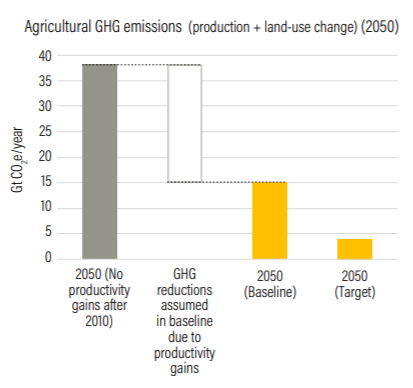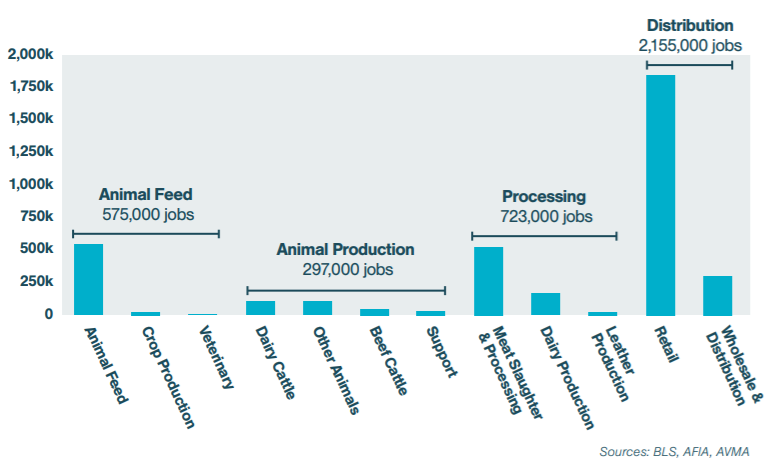Livestock Farming in the Future: Clean, Green and On-Screen?
There is plenty that makes the livestock industry an unattractive investment. Growth is coupled with significant consequences for the environment, with 15% of global greenhouse gas emissions attributed to the industry. Food safety concerns and disease outbreaks are increasingly reported in the news. Consumer demand in high-consumption countries is slowing in favor of alternative milks, meats and other non-animal products. These alternatives are constantly reducing the cost of production and look set to overtake the unit cost of production of traditional protein agriculture in the next decade. A recent modeling of this trend in a report from RethinkX is worth quoting at length:
“In the US, by 2030, demand for cow products will have fallen by 70%. Before we reach this point, the US cattle industry will be effectively bankrupt. By 2035, demand for cow products will have shrunk by 80% to 90%. Other livestock markets such as chicken, pig, and fish will follow a similar trajectory.”
Despite the expected decline in the US, global meat consumption will actually go up, driven by increasing affluence in countries such as China and India. Meat and seafood consumption will rise 78% in Asia by 2050. Productivity gains and environmental improvements are therefore required in the livestock industry. Figure 1 shows the productivity improvements that are expected between now and 2050 (the white bar). However, this report from the WRI points out that even assumed productivity gains may not go far enough.

The three key areas of growth are:
• Digitalization of data
• Reduction of livestock emissions
• Improvements in waste handling
Digitize
As with the fresh produce industry, what gets measured gets managed. Increasing quality and quantity of data in livestock systems has been a focus of startup innovation for some time, with companies such as HerdDogg, Cowlar and SmartBow all working on ear tags or neck collars to follow cattle movement in the field. Other competitors are focusing on in-barn solutions, such as Cainthus‘ stationary machine vision cameras or SomaDetect‘s sensor that is installed in the milking line itself. Each of these companies sells hardware and then provides a layer of data analytics and service, usually on a per head pricing model.
Start-ups are still selling the hardware part of their system as a competitive differentiator, but an increasing amount of value is derived from the software and service layers. Giving access to high quality and real time data drives intelligent decision-making tools for the customer, ie the farmer. Additionally, it is the quality and granularity of this data that is of most value to digital solutions’ other customers, such as feed sellers and other farm service providers. This access to on-farm data is valuable to feed sellers who are looking to improve the products’ real-world applications and fine-tune their offerings to farmers. This is why corporate investors, such as Wilbur Ellis’ Cavallo Ventures, invested in companies such as Performance Livestock Analytics, a developer of data analytics for cattle feedlots, which has since been acquired by animal health corporation Zoetis. A further example is Cargill’s investment in Cainthus, the in-barn machine vision system, in 2018.
Reduce Livestock Emissions
Route 1 to reducing the environmental impact of livestock emissions is the undesirable choice to not farm livestock. Route 2 is to reduce livestock emissions. This is increasingly possible with feed additives that reduce enteric fermentation (cow burps). According to the IPCC, enteric fermentation accounts for 27% of anthropogenic methane emissions and methane accounts for between 32% – 40% of agriculture’s greenhouse gas emissions.
DSM, the Netherlands-based health and nutrition company, think they have the answer. They have developed a feed additive called 3NOP (marketed as Bovaer) that is expected to be regulated for use in Europe by the end of this year and then rolled out elsewhere in 2021. The additive works instantaneously; adding a quarter-teaspoon to feed can reduce livestock emissions by 30%. This compound was discovered in 2013 and has undergone rigorous field testing over the past seven years, giving it an edge over some of the start-up innovations entering the market.
Mootral is developing a competitive product that reduces methane emissions using properties found naturally in citrus and garlic. Mootral’s business model differs in that the company has had their product verified by Verra, a developer of a private carbon offsetting marketplace. With this certification, Mootral’s product can offer the farmer a second revenue stream from selling the carbon credits associated with offsetting methane emissions. DSM have also registered their methane emissions reduction product with another carbon crediting agency, Gold Standard (as of 4/22/20).
Improve Waste Handling
Livestock waste is a critical part of the agricultural system. Manure is used as fertilizer for crops and it is a source of fuel, either dried or in a biogas facility. However, the price of manure has not changed in sixty years while all other farm costs have increased ten times. This means farmers are now often paying to get rid of manure, rather than seeing it as a revenue stream. With 3.9 million livestock farms worldwide producing ten tons of manure per day, the total available market is worth $3.9 trillion. Negative environmental impacts are increasing, with over-application and soil retention of heavy metals poisoning agricultural soils and, in turn, polluting groundwater supplies.
Cost alone is driving farmers to treat manure on-site, but regulatory pressure to clean up this aspect of the industry is growing in the EU and North America. One solution comes from Bluetector. The company has taken a typical municipal wastewater treatment technology and adapted it to handle the higher concentrations of nitrates that are present in manure. The circulation process and a proprietary bacteria dose are the inputs, while nitrogen gas and irrigation-safe water are the only outputs. The system does not use chemical additives which has increased the OPEX costs of competitive and older solutions in this market. Bluetector’s solution arrives in a container with a price tag of around $500,000, and they charge $2/ton for operation and maintenance. The farmer can expect one to two years return on investment. Challenges for the company include regulatory approval, although their home market of Germany is part of a wider European effort to increase regulatory pressure on good manure disposal practices. Another challenge is convincing farmers that it works. The company finished a successful pilot in 2019, has two customer orders to fulfil and is working with a private equity firm, along with some wealthy individuals who are willing to back further installations.
Another solution comes from Livestock Water Recycling. The Canada-based company uses a filtration process to extract concentrated liquid potassium and ammonia, phosphorous and nitrogen rich solids, and water. The system may have higher operational costs due to the addition of acids and a potentially high-power consumption in the evaporation stage but this may be offset by the high value crop inputs it is able to manufacture in the process. The company currently has fourteen sites operational across North America.
Keep an eye on…
It emerged this week that there may have been a price fixing attempt in the US beef industry during the COVID outbreak. As reported in many places, wholesale prices for processed beef rose 15% – 20% in the US despite the price paid to farmers decreasing 11% since January. This was despite the $5 per cwt premium that Tyson announced it would pay due to the difficult economic circumstances and high prices. This increase should be put in context, where prices are around $110 per cwt which is $10 below the cost of production, meaning Tyson only reduced losses in a difficult industry. With processing as the second highest employer in the supply chain (see figure 2), not passing on the profit from wholesale price increases could spell disaster for the industry’s workforce.



